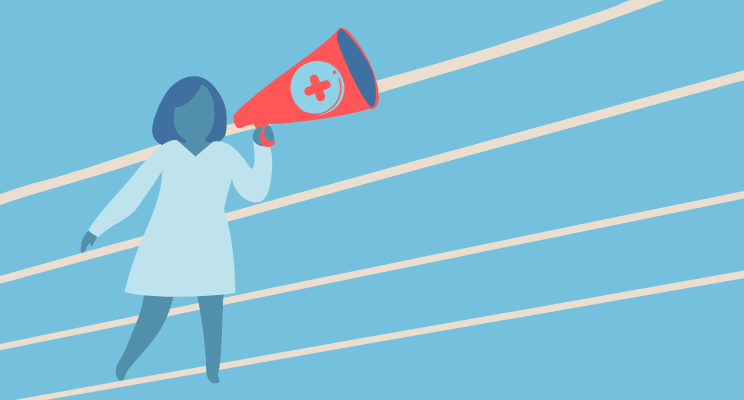Right before New York City issued its stay-at-home order (doesn’t that feel like a lifetime ago?), I rode the subway to work. The tension of COVID loomed, and I sensed the worry of my fellow subway passengers: the hesitation before sitting in a seat, gloved hands clutching handrails, nervous foot tapping. As we pulled into the 96th Street station, I yawned. The woman next to me snapped, “Cover your mouth. We don’t need your germs.” Shocked, I tried to reassure her, “It was just a yawn.” Without missing a beat, the woman yelled, “Don’t be disgusting,” before turning away from me. While my face flushed red, nearby passengers looked down at the ground. I felt embarrassed, confused, and ashamed. Then angry, as someone else coughed and the same woman didn’t bat an eye.
So goes the challenge of microaggressions: interpersonal interactions that communicate hostile, derogatory, or otherwise negative racial slights. They’re small cuts—but cuts, nonetheless—to your identity and spirit that leave you doubting yourself. Was there a racial underpinning to that rudeness, or did I imagine it? While my experience made me feel shame and embarrassment, others in the Asian Pacific American (APA) community, particularly those of East Asian descent, have experienced violence and fear. In late March, federal law enforcement issued a warning for an increase in hate crimes against Asian Americans. In just a month, the STOP AAPI HATE center received 1500 incident reports of harassment and assaults. The usage of terms like “Chinese virus” and “kung flu“ has only served to fuel this othering.
This May, as the pandemic persists, we celebrate Asian Pacific American Heritage Month: an opportunity to recognize the APA community and acknowledge the enduring challenges its members face. We in health communication have a particular responsibility to reflect on the messages and communication strategies that embolden discrimination. More than ever, we must tackle stigma and bias—and their influences over health.
The effects of stigma and discrimination
Epidemics and pandemics have a history of provoking xenophobia and stigma, and Asian bodies are not new targets for narratives connecting race and disease. Tackling COVID-19 requires an “all-in” approach, and scapegoating Asians and Asian Americans only muddles such a collective response. Worse, the racial prejudice and stigma attached to the coronavirus has treated all Asians as a monolith; in reality, Asian communities represent nearly 100 different ethnic groups with diverse cultures, dialects, and health needs. For example, I sit at the intersection of my Thai and Chinese identities. When we lump minority groups together, we fail to recognize and tease apart the different health needs and challenges that exist within groups.
It’s critical to acknowledge the connection between discrimination and health. Harmful rhetoric stokes stigma and discrimination, which can lead to poor health outcomes. Experiences of discrimination are psychosocial stressors associated with increased risk of mental disorders. And the effects can also be physical: discrimination is associated with negative physical health outcomes, including increased risk of adverse cardiovascular outcomes, oxidative stress, and inflammation. Not to mention the physical violence that can, and has, erupted because of prejudice and discrimination. Upstream factors come into play as well, as stigmatized groups may also experience denials of housing or employment, which can impact access to health care. When health communicators are aware of the pathways linking discrimination to negative health outcomes, they can take the necessary steps to elicit positive change for the health of all communities.
Communicators: watch your word and image choices
As we navigate the pandemic, APA Heritage Month offers an opportunity to thoughtfully consider bias and representation. In fact, it’s our responsibility as health communicators to limit bias and stigma, and their negative effects on health outcomes:
- Choose the right words: Language matters. In 2015, WHO issued guidance for naming infectious disease, emphasizing the fact that associating disease names with geographic regions doesn’t contribute to a productive medical understanding of illness. Terms like “Wuhan virus” or “China virus” needlessly racialize a disease and can actually do more harm than good. In these times, it’s more important than ever to use correct terminology.
- Consider imagery: We must exhibit care in the imagery we use in COVID-19 communication materials. For example, generic images of Chinatown shouldn’t be used as a way to illustrate the virus—doing so can engender biases and xenophobia.
- Amplify voices and denounce bias: Amplifying the voices of those who have lived experiences with coronavirus can offer reassurance to those who are worried and fearful. APA voices can contribute to understandings of the harms of stigma and bias. Call out anti-Asian sentiment, promote inclusion, and make sure that involved communities have a seat at the table.
- Refute myths, acknowledge fear: Facts matter. Dispel myths when you see them. Correct the record, especially if the myths harmfully target minority groups and conflate disease with race and geography. Communicators can correct misconceptions while acknowledging the COVID-19–related fear that fuels misinformation. Acknowledge this fear and direct people toward factual information that can help alleviate anxiety and dissipate bias.
Equitable communications can shine a light on communities that are disproportionately affected by the pandemic. Conversations on equity and inclusion have expanded especially as the media illuminates prejudice toward Asians through platforms like the #IAmNotTheVirus movement and documentaries. For health communicators, now is the time for allyship, facts, and unity. Together, we can catalyze progress—during APA Heritage Month and beyond.


